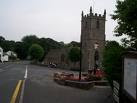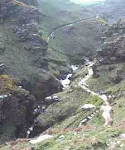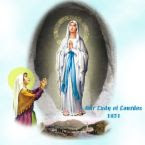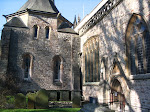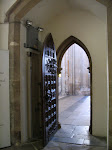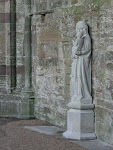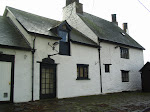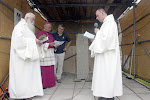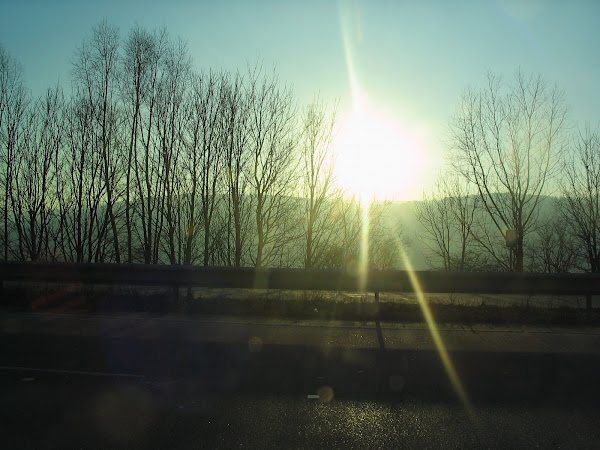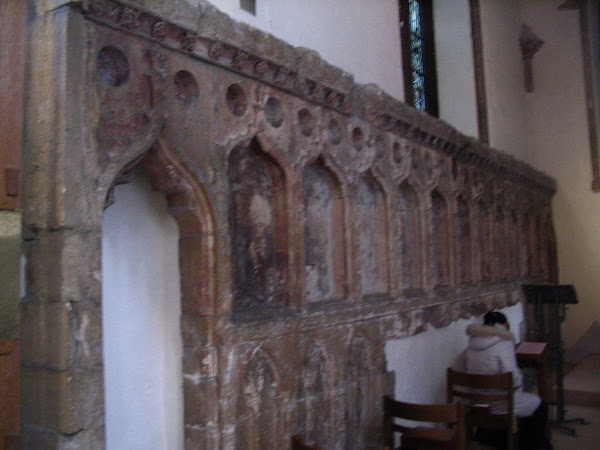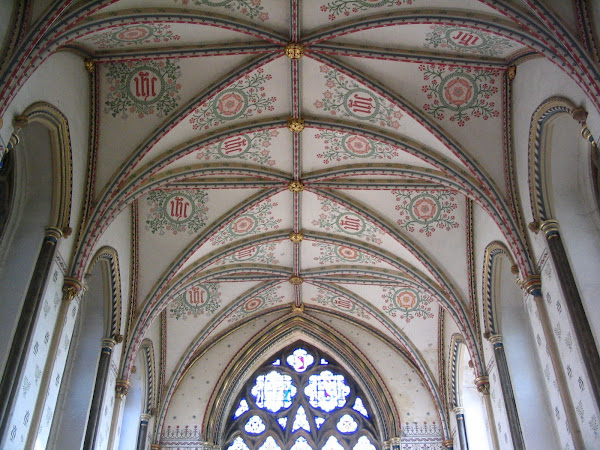












UP ON TO MOUNT CARMEL
Pantasaph lies very close to Holywell in a trough of land between the villages of Gorsedd and Brynford in rolling green countryside high above the Dee estuary. During the early nineteenth century it was a rather desolate piece of open country broken up with lead mines and a lime stone quarry.
The area always was Catholic and after St Kentigern (Mungo) refounded the monastery at St Asaph (originally founded by the Welsh St Elwy-of whom we know little) he left the settlement with Asaph after whom the settlement was named. In the 12th century the Norman invaders officially set up a Community which encompassed Powys. The Dociese remained Catholic until Bishop Thomas Goldwell was expelled by Queen Elizabeth in 1559, when it came to the family of the last Abbot Pennant.
The Family of Nicholas Pennant, Last Abbott
'Pantasaph' is first recorded in 1536 although spelt 'Pant Assay'when it was owned by Basinwerk (1131-Cistercians )In 1240 Davydd ap Llewellyn granted the church at Holywell, and the Well Shrine of St Winifride to the Abbey. The monks named the abbey after St Asaph, the local patron who had laboured , spreading the Kingdom in the area for many years. By 1537, Basinwerk was destroyed by Protestants and the last abbot, NICHOLAS PENNANT made it his business to distribute the Abbey lands among his relations to conserve it in Catholic hands. This was easily done, because his father, Thomas Pennant had been abbot before him, but resigned office to take a wife and four children. So the lands of Pantasaph remained in the Pennant Family for three hundred and nine years until 1846 when the sole heiress conveyed it by marriage to Rudolph, the 8th Earl of Denbigh.
Louisa Pennant eventually inherited not only Downing Hall, but all the lands owned by Basinwerk Abbey, including Pantasaph. Louisa married Rudolph in 1846 .They were devout Angicans and decided to build a church in thanksgiving for their marriage at Pantasaph .November 1847 the couple spent the winter abroad in Europe, travelling by carriage through France and Italy, arriving in Rome in January 1848. They were, graciously received byPope Pius IX and Louisa's catholic sympathies grew (remember the Catholic hierarchy in Britain was only just being restored in England) and there were still penalties on Cathlolics , even though they had not been enforced for some time. Rudolf's prejudice and anti-catholicism waned noticeably as he gained respect for the ancient church.
THE FEAST OF ST AUGUSTINE (28/8) 1850
In the summer of 1850 , Louisa felt sick and the couple travelled to Edinburgh to visit a medical consultant. While Louisa underwent treatment, Rudolph chose to go walking with a local clergyman. They discussed religious issues and Rudolph increasingly took the Catholic position. Louisa's illness grew worse and she suggested she wanted to join the Catholic Church and Rudolph decided to join her. This happened on the Feast of St Augustine on 29th August 1850.
CHURCH AT ST ASAPH NOW TO BE OFFERED TO THE CHURCH
Rudolph felt he could no longer offer the newly built church to the Anglican Church.He had built it for £10,000 out of his own and his wife's money, but since he and Louisa had become Catholics they decided to withdraw the offer to the Anglicans at St Asaph. There was a violent reaction by local protestants in Holywell ad Mostyn when an effigy of Rudolph was burned. Money flowed in from others, however, for the local Anglicans to build two churches at Gorsedd and Brynford for their own religion, so things worked out well . Undaunted, Rudolph continued with the new church,as an offering of gratitude for their marriage and their new found faith in the ancient faith.
FRIARS MINOR CAPUCIN
They spent much time in Italy for Louisa's health and mad ethe aquaintance of the Capuchin friars (of St Francis of Assissi). They were much taken by this order and their work with the oor, and decided they would make Pantasaph (dedicated to the Protector saint of Wales St David(St Dewi))and so Pantasaph became the mother house of the Friars Minor Capuchin of Great Britain.
LAW SUIT
Litigation followed but did not get anywhere and the courts upheld Rudolph's right to dispose of his property in any way he saw fit.The architect had been James WYATT who built the church in the neo-gothic style .Subsequently, Rudolph called in PUGIN who was called in to adapt the building for the celebration of Mass.Pugin was broadly satisfied by Welby's work, though he considered the chancel windows too small. The church was dedicated to St David and St Asaph.(The two patron saints of Wales are St David ad St Winifride)The Church was officially opened on 13th October 1852.
DEATH OF THE LADY LOUISA AND RUDOLPH's REMARRIAGE
Louisa eventually died of consuption at the family villa in Naples, and was embalmed and brought back to Pantasaph in the family vault.Four years later Rudolph was introduced to Mary Berkely of the Old Catholic familyof Spechley Park, Worcestershire and on 29th Septemeber 1857 they were married at Spechley by Cardinal Wiseman. 1864, the Old Earl died (Rudolph's father) and he became the 8th Earl of Denbigh .His wife had presented him by this time with five children and they lived as a model catholic family providing daily for the poor and sick at the gates of Downing Hall. Rudolph and Mary had joined the Third Order of St Francis (now nown as the secular Franciscan Order). This came to an end on 10th March 1892 when Rudolph died at Newnham Paddox . His body was brought by rail to Holywell Station and was carried from there by the friars to Pantasaph and was put in the vault next to his first wife.This is the end of the known history of Rudolph, Louisa and Mary.
THE LADY CHAPEL
To the right of the high altar is theLady Chapel , the exquisite reredos over the altar showing the Annunciation (Gabriel coming to Mary) and this was carved by Pugin and exhibited at the Great Exhibition of 1851. There is a tabernacle was put here after the Second Vatican Council.To the right of the chapel is a wonderful Pugin Madonna and CHild, one of the finest ever carved by Pugin and much admired at the Great Exhibition.
ST PRIMITIVUS
On the 25th May 1849 a year before the opening of the church, a Signor di Rossi in Italy identified the bones of a second century martyr, St Primitivus in the catacombs in Rome. Next to the bones was an earthenware vessel which contained the dried blood of the martyr and at the entrance of the tombof the grave a broken slab of ancient marble
Primitibus:d.v.k. Oct IX (Primitivus deposited on the 5th of the Kalends of COtober-(27 September))When Pope Pius IX learned of Rudolph's conversion, these relics were presented to him on thi return to Wales from Rome in 1851 . In August of that year they were finally installed in their oaken casket by Bishop Brown of Shrewsbury, beneath the Lady Altar. The original marble slab from the catacombs, may be seen at the base of the altar.
THE FRIARS
The Order is one of the three main branches of the Franciscan order .They arrived at Pantasaph in 1852. The friars set to work to beautify the lands around the church. Gardens were laid, trees planted and paths made and walls built and what was an ugly waste became the beautiful grounds we know today. This work had to be done in addition to the work over a large section of the local countryside to establish Mass centres, preach and bring the Sacraments to the faithful scattered Cathlics of North Wales.
THE SITE and the LOURDES GROTTO
Denbigh House where the friars lived until the present friary came into being stands at the head of the avenue leading up to the present building. To the right of the house a substantial path leads to the entrance to CALVARY -a steep zigzag path contains the fourteen stations of he cross erected at intervals in tiny chapels. The chapels were hewn and laid out and chapels built by the friars over the years.At the top of the Mount above the Chapel of the Sepulchre, stands Calvary proper a striking and impressive group in bronze. On coming back down the hill and opposite the first station a path leads to the Grotto,one of the finest seen anywhere. The grotto is a replica of that in Lourdes and is a tranquil haven where in spring and summer butterflies dance as pilgrims say their rosary prayers.Sadly there was no time to visit these sites as the walking is quite substantial. There is a large car park.
RETREATS and 1999 Shrine to St Pio
in 1987 the retreat centre was opened and there is a wide variety of retreats for groups and for individuals (Details stpioshrinepantasaph@catholic.org,or tel 01352 711053) Franciscan Friary, Monastery Ave, Pantasaph nr Holywell, Flintshire, CH8 8PE)Some people just come to enjoy the beautiful surroundings.
In 1999 the National Shrine to St Pio was opened and during the summer months 'St Pio Days of prayer'are run using the Shrine,Pilgrims Hall, Church and Grotto, all are welcome for these days and booking is available through the office in the last paragraph.
MARY in MONMOUTHSHIRE
I have included all these sites-Gwytherin Village of Winifride's work and burial,St Asaph Cathedral (originally Catholic) and the Shrine itself plus the Friary, simply because of the link with st Beuno, whose 'Vita' tells the story of Winifride and also because during Recusant times some articles were rescued from Monmouthshire Churches before they could be seized by those closing them down and taking away the churches property.They were taken and hidden at St Winifride until the Restoration of the Church.This shows also in this stronghold of the church, a link between the two strongholdsof Catholicism. The two areas contained 50% of Wales Catholics during Penal times.
This concludes February's pilgrimage to Holy Well. I am sure there will be more as the prayers I made to God at the Shrine were answered with the help of Winifride. The pictures at the shrine chapel below show thatalso Orthodox visit the shrine and chapel.




















